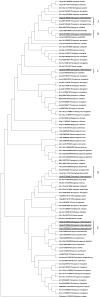Identification and characterization of high-molecular-weight glutenin subunits from Agropyron intermedium
- PMID: 24503781
- PMCID: PMC3913593
- DOI: 10.1371/journal.pone.0087477
Identification and characterization of high-molecular-weight glutenin subunits from Agropyron intermedium
Abstract
High-molecular-weight glutenin subunit (HMW-GS) is a primary determinant of processing quality of wheat. Considerable progress has been made in understanding the structure, function and genetic regulation of HMW-GS in wheat and some of its related species, but less is known about their orthologs in Agropyron intermedium, a useful related species for wheat improvement. Here seven HMW-GSs in Ag. intermedium were identified using SDS-PAGE and Western blotting experiments. Subsequently, the seven genes (Glu-1Aix1 ∼ 4 and Glu-1Aiy1 ∼ 3) encoding the seven HMW-GSs were isolated using PCR technique with degenerate primers, and confirmed by bacterial expression and Western blotting. Sequence analysis indicated that the seven Ag. intermedium HMW-GSs shared high similarity in primary structure to those of wheat, but four of the seven subunits were unusually small compared to the representatives of HMW-GS from wheat and two of them possessed extra cysteine residues. The alignment and clustering analysis of deduced amino acid sequences revealed that 1Aix1 and 1Aiy1 subunits had special molecular structure, belonging to the hybrid type compounding between typical x- and y-type subunit. The xy-type subunit 1Aix1 is composed of the N-terminal of x-type and C-terminal of y-type, whereas yx-type subunit 1Aiy1 comprises the N-terminal of y-type and C-terminal of x-type. This result strongly supported the hypothesis of unequal crossover mechanism that might generate the novel coding sequence for the hybrid type of HMW-GSs. In addition to the aforementioned, the other novel characteristics of the seven subunits were also discussed. Finally, phylogenetic analysis based on HMW-GS genes was carried out and provided new insights into the evolutionary biology of Ag. intermedium.
Conflict of interest statement
Figures






References
-
- Larwance GJ, Shepherd KW (1981) Chromsomal location of genes controlling seed protein in species realted to wheat. Theor Appl Genet 59: 25–31. - PubMed
-
- Payne PI (1987) Genetics of wheat storage proteins and the effect of allelic variation on bread-making quality. Annu Rev of Plant Physiol Plant Mol Biol 38: 141–153.
-
- Shewry PR, Tatham AS, Barro F, Barcelo P, Lazzeri P (1995) Biotechnology of breadmaking: unraveling and manipulating the multi-protein gluten complex. Nat Biotechnol 13: 1185–1190. - PubMed
-
- Halford NG, Forde J, Anderson OD, Greene FC, Shewry PR (1987) The nucleotide and deduced amino-acid-sequences of an HMW glutenin subunit gene from chromosome 1B of bread wheat (Triticum Aestivum L.) and comparison with those of genes from chromosomes 1A and 1D. Theor Appl Genet 75: 117–126.
Publication types
MeSH terms
Substances
LinkOut - more resources
Full Text Sources
Other Literature Sources
Miscellaneous

